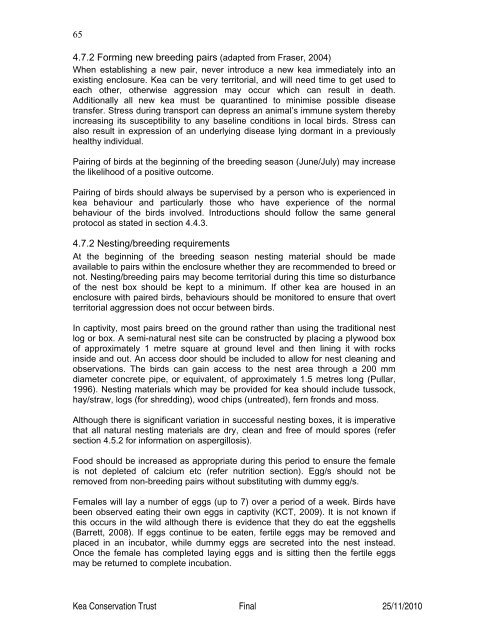(Nestor notabilis) Husbandry Manual - Kea Conservation Trust
(Nestor notabilis) Husbandry Manual - Kea Conservation Trust
(Nestor notabilis) Husbandry Manual - Kea Conservation Trust
You also want an ePaper? Increase the reach of your titles
YUMPU automatically turns print PDFs into web optimized ePapers that Google loves.
65<br />
4.7.2 Forming new breeding pairs (adapted from Fraser, 2004)<br />
When establishing a new pair, never introduce a new kea immediately into an<br />
existing enclosure. <strong>Kea</strong> can be very territorial, and will need time to get used to<br />
each other, otherwise aggression may occur which can result in death.<br />
Additionally all new kea must be quarantined to minimise possible disease<br />
transfer. Stress during transport can depress an animal’s immune system thereby<br />
increasing its susceptibility to any baseline conditions in local birds. Stress can<br />
also result in expression of an underlying disease lying dormant in a previously<br />
healthy individual.<br />
Pairing of birds at the beginning of the breeding season (June/July) may increase<br />
the likelihood of a positive outcome.<br />
Pairing of birds should always be supervised by a person who is experienced in<br />
kea behaviour and particularly those who have experience of the normal<br />
behaviour of the birds involved. Introductions should follow the same general<br />
protocol as stated in section 4.4.3.<br />
4.7.2 Nesting/breeding requirements<br />
At the beginning of the breeding season nesting material should be made<br />
available to pairs within the enclosure whether they are recommended to breed or<br />
not. Nesting/breeding pairs may become territorial during this time so disturbance<br />
of the nest box should be kept to a minimum. If other kea are housed in an<br />
enclosure with paired birds, behaviours should be monitored to ensure that overt<br />
territorial aggression does not occur between birds.<br />
In captivity, most pairs breed on the ground rather than using the traditional nest<br />
log or box. A semi-natural nest site can be constructed by placing a plywood box<br />
of approximately 1 metre square at ground level and then lining it with rocks<br />
inside and out. An access door should be included to allow for nest cleaning and<br />
observations. The birds can gain access to the nest area through a 200 mm<br />
diameter concrete pipe, or equivalent, of approximately 1.5 metres long (Pullar,<br />
1996). Nesting materials which may be provided for kea should include tussock,<br />
hay/straw, logs (for shredding), wood chips (untreated), fern fronds and moss.<br />
Although there is significant variation in successful nesting boxes, it is imperative<br />
that all natural nesting materials are dry, clean and free of mould spores (refer<br />
section 4.5.2 for information on aspergillosis).<br />
Food should be increased as appropriate during this period to ensure the female<br />
is not depleted of calcium etc (refer nutrition section). Egg/s should not be<br />
removed from non-breeding pairs without substituting with dummy egg/s.<br />
Females will lay a number of eggs (up to 7) over a period of a week. Birds have<br />
been observed eating their own eggs in captivity (KCT, 2009). It is not known if<br />
this occurs in the wild although there is evidence that they do eat the eggshells<br />
(Barrett, 2008). If eggs continue to be eaten, fertile eggs may be removed and<br />
placed in an incubator, while dummy eggs are secreted into the nest instead.<br />
Once the female has completed laying eggs and is sitting then the fertile eggs<br />
may be returned to complete incubation.<br />
<strong>Kea</strong> <strong>Conservation</strong> <strong>Trust</strong> Final 25/11/2010












